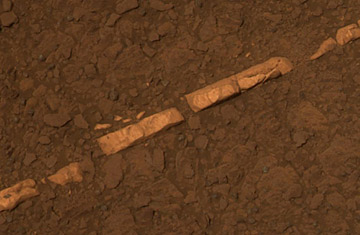
View of a mineral vein on Mars, taken by the Opportunity rover
Say this for earthlings: we've grown up a lot since the time we went nuts over the mysterious face on Mars. The face was discovered in 1976, as the orbiting Viking 1 spacecraft looked down on the planet's Cydonia region and found what appeared to be a dark-eyed set of stony features staring back at it. This gave rise to a lot of fevered talk about a vanished (or extant!) civilization signaling its presence, and even to merchandising opportunities, including art prints of the eerie face. It also figured prominently in the execrable Brian De Palma movie Mission to Mars. (The man who inflicted Scarface should surely have stopped before Marsface.)
Cooler heads eventually prevailed after the Mars Global Surveyor resurveyed the site in 1998 and proved that the face was just a mesa, and one that had been heavily windblown over the years at that. The face, in effect, was erased.
Happily, there was no similar silliness last week when NASA revealed that the Opportunity rover, which has been prowling the plains and craters of the Red Planet since 2004, had discovered, well, Martian patio tiles — or rectangular formations that looked awfully similar. O.K., rectangles in the Martian soil are admittedly less sexy than faces, but while the face had nothing at all to do with life, the rectangles are one more clue that biology might indeed be — or at least have been — possible on Mars.
Opportunity and its rover twin Spirit have spent much of their years of exploration looking for clues to water on Mars, which, of course, is a sine qua non for life as we know it. The evidence has piled up — both in terms of topographic scars that could only have been left by flowing, pooling or upwelling water; and the presence of sulfates, hydroxides and other materials that form in the presence of water. Last August, the Mars Reconnaissance Orbiter (MRO) beamed back images suggesting that liquid water may flow seasonally on Mars even today.
"Since the MRO arrived at Mars, our overarching theme has been 'follow the water,'" said mission scientist Mike Meyer at the time of the announcement. "Now we may be catching Mars in the act."
Last week's finding was just as dramatic, though for different reasons. The images Opportunity returned showed a vein of gypsum about the width of a human thumb and running 16 to 20 in. (40 to 50 cm) in length. Ninety-degree fractures along the stretch gave it the look of painted road lines and the fact that the gypsum was not flush with the surface bedrock is what gave it the three dimensionality of tiling.
Opportunity discovered the vein on the rim of Endeavour Crater, a 14-mile (23 km) diameter formation on the planet's Meridiani Planum. The rover examined the find with microscopic imager, its panoramic camera and its x-ray spectrometer. That last instrument detected calcium sulfate, a mineral typically deposited by water. Calcium sulfate comes in different varieties, and the type there is almost surely gypsum, an especially hydrated — or waterlogged — form of the mineral.
"We suspect that groundwater emerged and then quickly precipitated out the least soluble of the sulfate salts dissolved in it, which would have been gypsum," says Cornell University's Steve Squyres, principal investigator for the Opportunity program. "The width of fractures in the ground controls the width of the veins."
It's the site of the gypsum that makes it significant as well. Plenty of the material has been observed on Mars before, but it's often a dusting scattered across broad plains in the planet's north, which suggests it was wind-borne from somewhere else. Precisely where is uncertain. The Endeavour deposit, by contrast, appears to be in its original location. There's no way of knowing if there was enough water in the crater for enough time to have given rise to life, though it's tempting to think that a wet crater could have become a de facto lake — a possible incubator for biology. In this case, however, Squyres doubts it. "There's no evidence for water pooling in the crater," he says. "It's evidence for groundwater."
Still, that could be enough. Opportunity will continue to study the find and look for more such signs of Mars's soggy past for as long as it continues to function. The Spirit rover went silent in 2010 after six years of exploration, and Opportunity itself is now creaking, with scientists always taking care to park it on the sunward side of Endeavour, the better to wring what power they can from its aging solar panels. Now en route, however, is Curiosity, the SUV-sized descendant of Spirit and Opportunity, set to arrive on Mars in August. It's impossible to know whether Curiosity and Opportunity will have the chance to explore simultaneously or if Opportunity will have winked out by then. No matter what, Curiosity will continue to do the same work its rover predecessors have done, following the water — and the life it might one day reveal.
